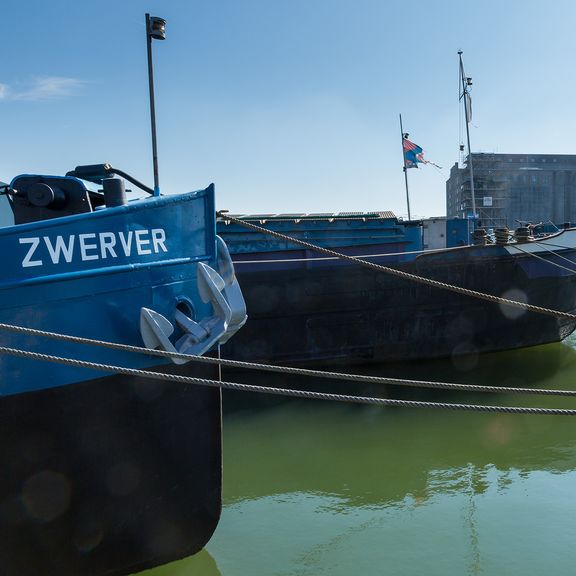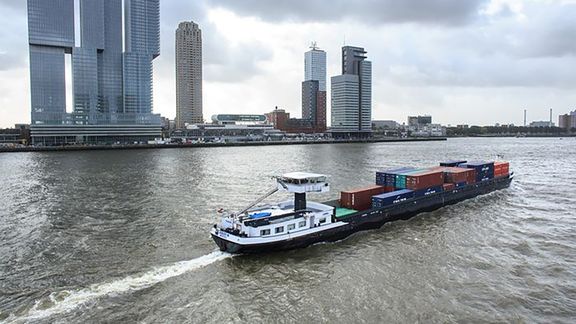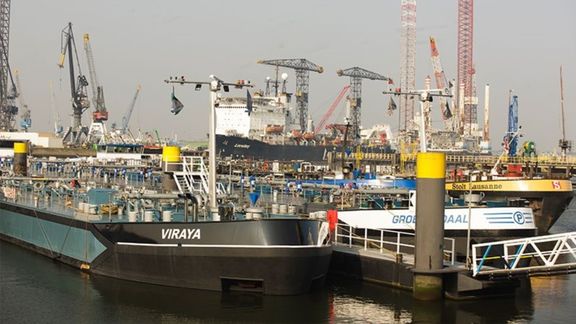
Berths for inland shipping
Public berths in Rotterdam city area
If you are visiting the port of Rotterdam, you can make use of the berths for inland shipping. In the urban areas of Rotterdam a large number of public berths are available. The berths can be identified by traffic signs indicating that inland vessels can take berth.
Berths in Rotterdam are intended for vessels in the categories indicated on the traffic signs and markings, such as barges and hazardous goods. You are allowed to use berths in the port of Rotterdam if you comply with the following criteria:
- You have a permit on the basis of the Quay Dues Bye-law.
- You have the permission of the renter or lessee of the site the berth is located on.
- You have the permission of the Harbour Master.
Unless indicated otherwise, the berths can only be used by inland vessels that actively participate in professional shipping. You should be able to prove this by means of documents such as the sailing time book.

Berths in Rotterdam and the Drecht cities
The maps show the berths for inland shipping in Rotterdam and the Drecht cities. The maps indicate the ships' maximum allowable length and the maximum number of ships allowed. The markings printed on the maps indicate the type of ship allowed to moor at that particular berth. The indication 3x>95 for example, means that a maximum of three ships longer than 95 meters are allowed to moor there. The indication B<35 means that only ships up to a combined width of 35 metres are allowed to moor there. The traffic signs on the map are part of the Inland Waterways Police Regulations. At some berths, ships are exempt from carrying anchor lights. You can find these in the Shipping announcements.
Open the map, click in the map first then zoom or pan.
Use of spud poles (or anchors)
Rules for the use of spud poles are specified in the (new) port regulation 2020 under Article 3.7 ‘Use of anchors and spud poles’.
Spud poles are only permitted:
a. In areas designated by the college;
b. If this is in accordance with the traffic signs and further indications applied on site or with a decision with the same meaning as a traffic sign, or;
c. If the use thereof does not cause any damage to infrastructure, underground infrastructure installed in the underwater bed or shore or quay defences. A notification of this must be made to the harbour master prior to the use of spud poles.
Item b). The relevant Shipping Announcements are:
• Shipping Announcement also Traffic Order Calandkanaal/Seinehaven/Hartelkanaal
• Announcement with the same meaning as a traffic sign regarding the use of spud poles, Yangzekanaal/Europahaven/Mississippihaven/Hartelhaven/Waalhaven, Rotterdam
Item c) This is a change with respect to the previous regulation. The use of spud poles was initially forbidden therein. It was possible to apply for an exemption when a vessel wanted to use a berth with spud poles outside an area that had been designated.
Since the entry into force of the new port regulation on 6 January, the use of spud poles outside the designated areas is, in principle, permitted if no damage is caused to the infrastructure, the underground infrastructure installed in the underwater bed or shore quay defences. You must always report this to the harbour master prior to use.
Please note! You should always ensure that the use of spud poles cannot cause any damage prior to installing them.
Up-to-date information about the infrastructure, underground infrastructure installed in the underwater bed or shore and quay defences is available from the harbour master and can be requested from the HCC. Naturally, we endeavour to provide you with information immediately. However, because this information must first be requested from the relevant soil manager, this will not always be possible. We therefore ask that you inform us of your intention to install spud poles as early as possible.
Finally, the Port of Rotterdam Authority has contracts with various contractors. These parties are familiar with the current status of the soil, infrastructure and frameworks. The obligation to report to the harbour master also applies to them in this case.
Special circumstances
It is possible that circumstances require the berth to be abandoned immediately. This can be the case for example if there is an impending danger, a special transport, a ship launch, an event, or if the berth gets a change of use. If this is the case, you will be informed via VHF. To take berth at another location, permission from the Harbour Coordination Centre is required.

Availability of berths
The Port of Rotterdam Authority will be happy to assist you in finding an available berth. In the port of Rotterdam, you can check the current occupation of berths for inland shipping on a digital map. You can do so via the Inland Shipping Berth Information System (BLIS). The system helps you to avoid unnecessary shipping movements, reducing costs such as for fuel. BLIS originates from the Blauwe Golf Verbindend project. In this project, the Port Authority works with a number of parties to achieve a better exchange of information between waterway managers, waterway users and road traffic. In the future, it should also be possible to share information about opening hours of bridges and locks via this system. We are currently also developing an app.